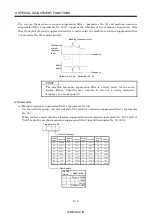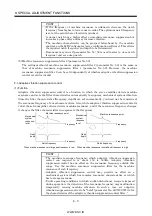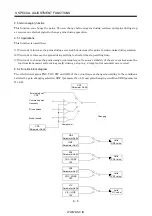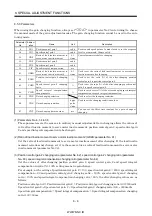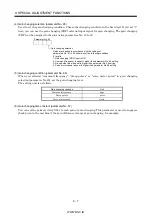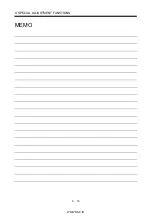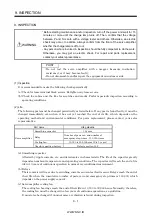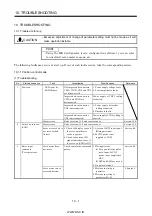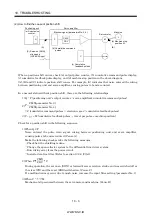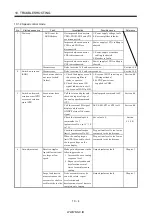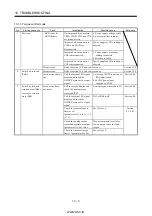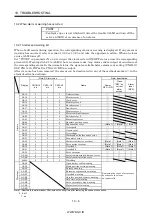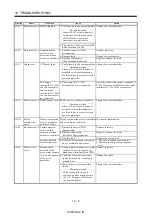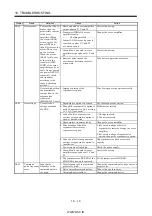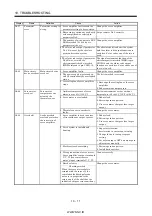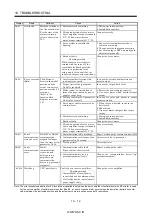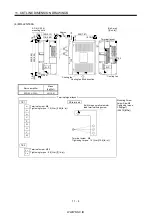
WWW.NNC.IR
10 - 4
10. TROUBLESHOOTING
10.1.2 Speed control mode
No.
Start-up sequence
Fault
Investigation
Possible cause
Reference
Not improved if connectors
CN1A, CN1B, CN2 and CN3
are disconnected.
1. Power supply voltage fault
2. Servo amplifier is faulty.
Improved when connectors
CN1A and CN1B are
disconnected.
Power supply of CN1 cabling is
shorted.
Improved when connector
CN2 is disconnected.
1. Power supply of encoder
cabling is shorted.
2. Encoder is faulty.
LED is not lit.
LED flickers.
Improved when connector
CN3 is disconnected.
Power supply of CN3 cabling is
shorted.
1
Power on
Alarm occurs.
Refer to section 10.2 and remove cause.
Section 10.2
Alarm occurs.
Refer to section 10.2 and remove cause.
Section 10.2
2
Switch on servo-on
(SON).
Servo motor shaft is
not servo-locked
(is free).
1. Check the display to see if
the servo amplifier is
ready to operate.
2. Check the external I/O
signal indication to see if
the servo-on (SON) is ON.
1. Servo-on (SON) is not input.
(Wiring mistake)
2. 24VDC power is not
supplied to COM.
Section 6.6
Call the status display and
check the input voltage of
the analog speed command
(VC).
Analog speed command is 0V.
Section 6.2
Call the external I/O signal
display and check the
ON/OFF status of the input
signal.
LSP, LSN, ST1 or ST2 is off.
Section 6.6
Check the internal speed
commands 1 to 7
(parameters No. 8 to 10 72
to 75).
Set value is 0.
Check the internal torque
limit 1 (parameter No. 28).
Torque limit level is too low as
compared to the load torque.
3
Switch on forward
rotation start (ST1)
or reverse rotation
start (ST2).
Servo motor does
not rotate.
When the analog torque
limit (TLA) is usable, check
the input voltage on the
status display.
Torque limit level is too low as
compared to the load torque.
Section
5.1.2 (1)
Rotation ripples
(speed fluctuations)
are large at low
speed.
Make gain adjustment in the
following procedure.
1. Increase the auto tuning
response level.
2. Repeat acceleration and
deceleration several
times to complete auto
tuning.
Gain adjustment fault
Chapter 7
4
Gain adjustment
Large load inertia
moment causes the
servo motor shaft to
oscillate side to side.
If the servo motor may be
run with safety, repeat
acceleration and
deceleration several times to
complete auto tuning.
Gain adjustment fault
Chapter 7
Summary of Contents for MR-J2S-*A
Page 13: ...WWW NNC IR A 12 MEMO ...
Page 117: ...WWW NNC IR 3 70 3 SIGNALS AND WIRING MEMO ...
Page 185: ...WWW NNC IR 7 12 7 GENERAL GAIN ADJUSTMENT MEMO ...
Page 195: ...WWW NNC IR 8 10 8 SPECIAL ADJUSTMENT FUNCTIONS MEMO ...
Page 197: ...WWW NNC IR 9 2 9 INSPECTION MEMO ...
Page 221: ...WWW NNC IR 11 10 11 OUTLINE DIMENSION DRAWINGS MEMO ...
Page 293: ...WWW NNC IR 13 64 13 OPTIONS AND AUXILIARY EQUIPMENT MEMO ...
Page 321: ...WWW NNC IR 14 28 14 COMMUNICATION FUNCTIONS MEMO ...
Page 389: ...WWW NNC IR 15 68 15 ABSOLUTE POSITION DETECTION SYSTEM MEMO ...

